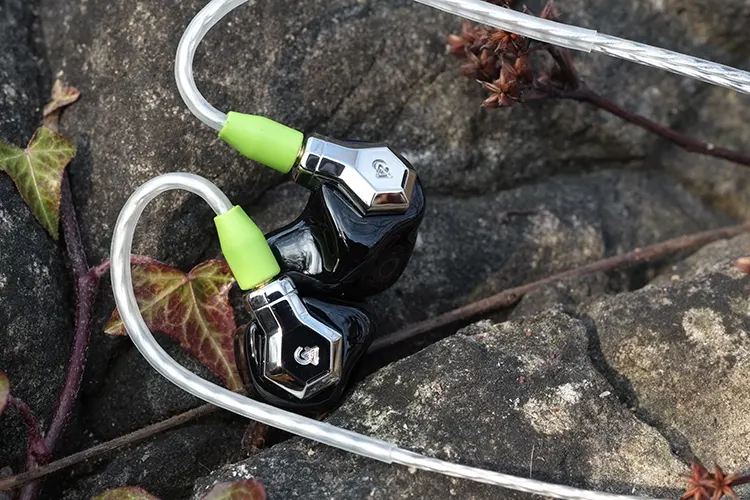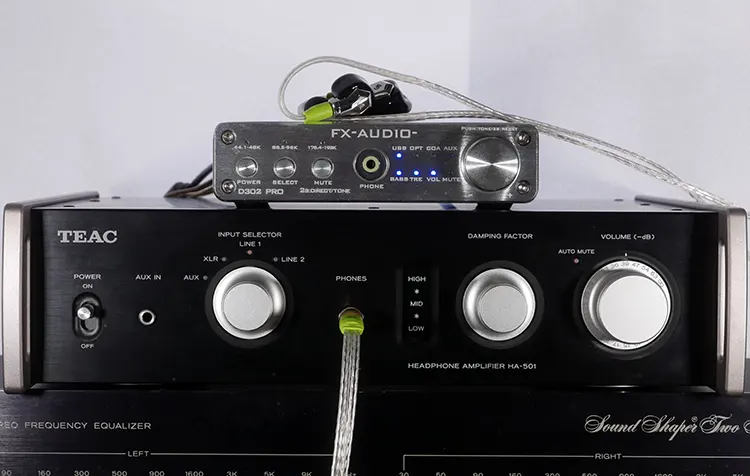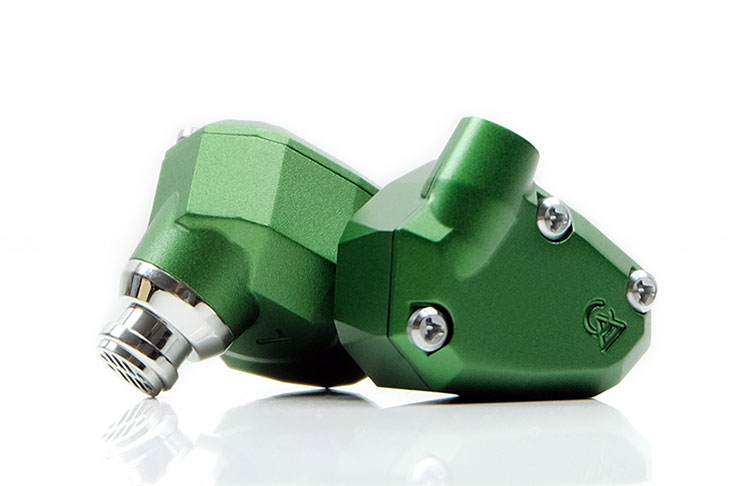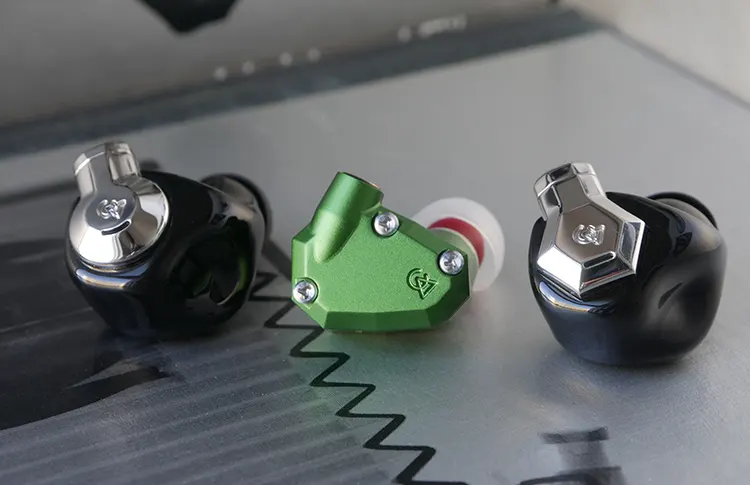Synergy
Efficiency
The Ponderosa has a sensitivity of 94 dB @ 1 kHz: 8.1 mVrms and an impedance of 6Ω @ 1 kHz.
This is an earphone that is easy to bring up to volume. It can be comfortably driven by the average headphone output on a phone or dap without the need for an external amplifier.
While not nearly as much of an issue as with older Campfire Audio products, background hiss with certain devices is present. An impedance adapter is a useful tool to have on hand.
Dongle Pairings
I used the Cozoy Takt C and ddHiFi TC44C dongles. To see how the Ponderosa handled a balanced output, a 4.4mm balanced cable from Astrotec was used to connect with the TC44C.
The Takt C has a cool and clinical signature so if you find the Ponderosa’s thick low end too much, the Takt C thins it out leaving the presentation lighter and leaner. The mid-range loses some density while the upper ranges sound sharper and more defined.
The Takt C does not make the Ponderosa’s soundstage feel any larger. However, the thin note presentation of the Takt C opens the space between track elements, allowing the Ponderosa to better utilize its existing soundscape.
The Ponderosa’s easy-to-drive qualities mean I am almost always listening at the lowest volume. In a dead-quiet environment, the Ponderosa/Takt C combo is simply too loud.
Background hiss is audible during quiet moments and may require an impedance adapter to quell. A device like this also helps with the volume issues I experienced, enabling a more usable volume range.
Out of the 4.4mm balanced port, ddHiFi’s TC44C offers an entirely uncolored sound that does nothing to alter the Ponderosa’s balance. This alone makes it a better choice than the Takt C if you prefer a dongle that does not alter the standard signature.
The TC44C matches the Takt C’s technical prowess while having a black, hiss-free background at any volume, the minimum of which I can comfortably listen to regardless of the source in play. It is a more versatile product and a better match to the performance expectations of a product at the Ponderosa’s level.
It does have a meatier presentation than the Takt C though, so the soundstage benefits you get with that dongle are not present when paired with the TC44C.
Desktop Pairings
TEAC’s vintage-inspired HA-501 was my high-end and preferred option. The D302 Pro from FX Audio was a more budget-friendly pick that did a solid job.
The HA-501 features a Damping Factor that when lowered adds resistance and cleans up the background, helping to reduce mid-bass. Paired with the Ponderosa, the second lowest setting of five best balanced the low-end presence.
Unlike the 70’s-inspired HA-501, the D302 Pro provides a more sterile, modern sound experience. To roughly match the HA-501, the bass was set to 9/15 and the treble set to 5/15.
The D302 Pro’s crisp and sharp note presentation better defined the Ponderosa’s treble clarity and detail. The same qualities through the HA-501 were softer and more mellow with less upper treble emphasis without restricting the level of detail or clarity the earphone could provide.
The midrange of the HA-501 provided a warmer sound with greater depth that better suited the Ponderosa’s vocal and instrument presentation. The D302 Pro added a digital edge to the presentation that highlighted minor details, at the cost of sounding sterile.
Bass from the Ponderosa was more natural from the HA-501 with a depth to the presentation that the D302 Pro could not replicate. The D302 Pro better let the armatures in the Ponderosa shine in terms of speed and punch in the low end.
Staging and dynamics through the HA-501 were superior, letting the Ponderosa sound wider, deeper, and taller, with better instrument separation and a blacker background. The D302 Pro’s presentation lacked the layering and precision of the HA-501’s channel-to-channel movement.
Both amps produce background noise with the Ponderosa, the HA-501 being the more lenient of the two. It’s a non-issue at normal listening volumes, but an impedance adapter might be worth looking into if pairing the Ponderosa with a headphone-focused desktop amp.
Select Comparisons
Campfire Audio Andromeda 2020
Technical
The Ponderosa and Andromeda 2020 are exceptionally similar on paper. Both earphones contain five balanced armatures per side in the same configuration: two for the high-range, one for the mids, and two for the low-range.
They both feature T.A.E.C technology applied to the high-range drivers, a Solid-Body Design, and Beryllium/Copper MMCX connectors.
Sensitivity is slightly higher on the Andromeda at 7.01 mVrms compared to 8.1 mVrms to hit 94 dB @1kHz. The Andromeda 2020’s impedance sits at 12.8Ω @ 1kHz compared to the Ponderosa’s 6 Ω @1kHz.
Design
The Andromeda 2020 features Campfire Audio’s recognizable, lightweight (22.6g with the stock cable, 11.9g earpieces only), and milled aluminum shells. Comparatively, the Ponderosa features a heavier (40.1g with the stock cable, 15.9g earpieces only) custom-inspired acrylic shell.
When I take the Andromeda 2020 outdoors, I find it does a great job isolating everything but voices. Regardless of the tips used, be they foam or silicone, voices cut through.
The Ponderosa blocks everything equally well, especially if you opt for the included Marshmallow foams. I am sure the size and the fact it fills the entire ear helps with this.
Comfort was never an issue for the Andromeda 2020 thanks to the softened edges of the updated shell. As such, both models are perfectly wearable for long periods.
They both slot into my ears exceptionally well, but the Andromeda 2020 will shift occasionally, requiring it to be reseated to regain a good seal. This is something I rarely have to do with the Ponderosa.
Aesthetically I feel the Andromeda is the more appealing of the two as its timeless design helped put Campfire Audio on the map. It has been used across numerous models in Campfire’s lineup and as such is no longer unique, but this just further points to its iconic design status.
While lacking the distinctness of the Andromeda, the Ponderosa is no slouch for aesthetics. The custom-like main body is common by design leaving the bright green cable accents, should you option them, and reflective steel backing to perform “eye-catching” duty.
Drawing from past products like the Comet and Atlas, the hexagonal design motif of the backing ensures the Ponderosa identifies as a Campfire Audio product. This evolutionary approach is smart, as a hard shift to a completely new design language can be jarring.
Performance
The Andromeda 2020 and the Ponderosa provide similar quantities of bass from lower to upper. The Ponderosa’s presentation is thicker and more visceral, with the deepest notes providing more physical feedback.
Both models are equal when it comes to speed and articulation. The Andromeda is grittier and more textured, with the Ponderosa offering a smoother, more refined experience.
Up until around 2k, their frequency responses are equal in emphasis. After that, the Andromeda drops emphasis slightly while the Ponderosa holds on through to the upper mids.
This gives the Ponderosa a sweeter, more natural vocal presentation and as a result leaves it as the more competent of the two for vocal-centric media. Oddly, it also better handles sibilant tracks, though neither is sibilant in their default presentation.
The treble region of the Ponderosa provides more energy in both the presence and brilliance regions. It also improves upon Andromeda’s already impressive levels of clarity and detail, though this comes at the expense of some newly introduced harshness in hi-hats that play in the lower treble area.
The Ponderosa plays on a smaller but more well-defined stage. Andromeda’s staging is vaster and more open, but also more vague and less predictable in where sounds will end up.
Campfire Audio Cascara
Technical
While they may look alike on the outside and both utilize Solid Body Design, inside the Cascara and Ponderosa are quite different.
The Ponderosa features a complicated five-armature driver configuration while the Cascara takes a more straightforward approach with a newly developed, dual-magnet dynamic driver.
The Cascara has a sensitivity of 94 dB @ 1 kHz: 16.6 mVrms which is a bit lower than the Ponderosa. Impedance is significantly different with the Cascara polling at 23Ω @ 1kHz to the Ponderosa’s 6 Ω @ 1kHz.
Design
As part of the same series, they share their design language and the technology used in the creation of their shells. Were it not for the Cascara’s rounded backplate design, I would be unable to tell the two apart upon a simple visual inspection.
While the Cascara’s earpieces are ever so slightly heavier at 16.4g without a cable, compared to the 15.9g of the Ponderosa, this too is such a minimal difference as to be deemed insignificant. They feel identical in the ear and as such, equally comfortable.
Isolation on the other hand is not the same, with the Ponderosa blocking out at least a few additional decibels of noise. This is in line with my experience when comparing the isolation of armature-based earphones and dynamic-based earphones.
Going back to the Cascara’s rounded backplate design, I think it fits the blue colorway Campfire Audio chose. Blue is a relaxing color, and soft, rounded edges match that emotional aesthetic, while bright green is edgy and energetic, matched by the Ponderosa’s angular backplate design.
I appreciate that the chosen colors and designs match stylistically, but the Ponderosa’s more dynamic aesthetic is more attractive to my eye. On the other hand, the shade of blue selected for the Cascara is right up my alley so a cable swap might be in order down the road.
Performance
The Cascara extends further into sub-bass regions while having considerably more emphasis throughout the entire range.
The dual-magnet system does a good job of keeping things snappy and in control, but it can’t quite match the speed or texturing of the dual armatures in the Ponderosa.
Details are a step behind, and the prominent mid-bass emphasis can lead to bloat where there is none in Ponderosa’s presentation. It also adds additional warmth beyond what is offered in the Ponderosa.
Much of the mid-range of the Cascara is boosted over what is heard in the Ponderosa which helps ensure vocals are not drowned out by all that bass.
The lower mid-emphasis can make the Cascara sound cloudy when compared to the Ponderosa, but both are restrained around 1k so neither comes across as tinny or fatiguing.
With the emphasis on the upper mids being greater on the Cascara, instruments attack with more force than on the Ponderosa. However, the Ponderosa has a more natural and believable timbre.
Treble emphasis is placed lower in the range on the Ponderosa resulting in improved clarity and detail over the Cascara. The Cascara’s brilliance region emphasis results in a leaner, more open, and vibrant upper range with a level of shimmer and sparkle the Ponderosa is lacking.
Thanks to the abundance of low-end delivering a wide floor on which the rest of the stage is built, the Cascara has a larger sound stage. Even though it is larger in virtually every dimension, the Ponderosa’s technical advantages make up for it.
With improved layering, instrument separation, and accuracy in channel-to-channel movement, the Ponderosa’s staging is precise and technical whereas the Cascara’s is merely suggestive but bold.
Our Verdict
The Ponderosa is a worthy addition to Campfire Audio’s universal IEM lineup and provides a familiar but unique experience to those who already own earphones from the brand.
The tuning it provides is technically capable and versatile with a widespread appeal thanks to a warm, robust low-end, and energetic, but non-fatiguing mid and upper range.
It’s easy to bring up to volume, isolates well, the Time Stream cable is outstanding, and the various customization options add plenty of personalization for those who want it.
While not without faults, the Ponderosa is a comparatively affordable way to get a high-performance earphone that does pretty much everything well.
Campfire Audio Ponderosa Technical Specifications
- Frequency Response: 5Hz–20 kHz
- SPL: 94 dB @ 1 kHz: 8.1 mVrms
- Impedance: 6Ω @ 1 kHz
- Less than 1% Total Harmonic Distortion






